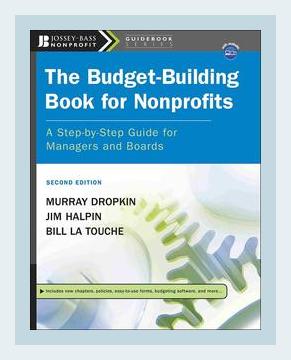Finance and AccountingBudgeting and Forecasting
**
Introduction
“The Budget-Building Book for Nonprofits” by Murray Dropkin is a comprehensive guide designed to help nonprofit organizations create, manage, and maintain effective budgets. The book emphasizes the critical role of budgeting in ensuring nonprofit sustainability and service delivery. It encompasses practical advice, actionable steps, and concrete examples to facilitate both novice and experienced nonprofit professionals in their financial planning.
Chapter 1: Understanding the Importance of Budgeting
Key Points
- Budgets as a Planning Tool: Budgets serve as a roadmap for allocating resources in alignment with organizational goals.
- Facilitating Decision-Making: A well-crafted budget enables informed decision-making.
- Enhancing Transparency: Budgets enhance accountability and transparency among stakeholders.
Actions a Person Can Take
- Identify Goals: Establish clear organizational goals aligned with your mission to guide budget planning.
- Stakeholder Involvement: Involve key stakeholders in the budget process to enhance buy-in and accountability.
Example
- Scenario: A nonprofit aiming to expand its outreach programs must allocate funds effectively. By developing a detailed budget reflecting projected costs and anticipated funding sources, the organization ensures it can support the expansion without compromising existing programs.
Chapter 2: Components of a Budget
Key Points
- Revenue Projections: Accurate estimation of revenue sources, including grants, donations, and service fees.
- Expense Forecasting: Detailed forecast of all operating expenses, including personnel, program, and administrative costs.
- Variance Analysis: Regular review of actual expenses versus budgeted amounts to identify discrepancies.
Actions a Person Can Take
- Revenue Analysis: Conduct a historical analysis of previous revenue streams to inform future projections.
- Expense Categorization: Categorize expenses into manageable segments (e.g., salaries, marketing, office supplies) for better control.
Example
- Scenario: An animal shelter projecting revenues from adoptions, grants, and fundraising events should forecast based on historical data and planned activities, ensuring each revenue source is realistically estimated.
Chapter 3: Steps in Creating a Budget
Key Points
- Assessing Financial Position: Begin with a financial assessment to understand the current fiscal situation.
- Setting Financial Goals: Define short-term and long-term financial goals.
- Develop Budget Assumptions: Make informed assumptions based on market trends and organizational needs.
Actions a Person Can Take
- Financial Assessment Report: Compile a detailed financial report of your current fiscal position.
- Short-Term and Long-Term Planning: Set achievable financial goals for the next fiscal year and beyond.
Example
- Scenario: A youth organization assessing its financial position discovers surplus funds and decides to create a reserve for future projects, setting both immediate and long-term financial goals.
Chapter 4: Engaging Stakeholders
Key Points
- Board Involvement: Engage the board of directors in the budgeting process for strategic alignment.
- Staff Participation: Involve staff in budget discussions to leverage their operational insights.
- Donor Communication: Ensure transparency with donors about how funds are budgeted and utilized.
Actions a Person Can Take
- Board Meetings: Schedule regular board meetings specifically to discuss budget planning and reviews.
- Staff Workshops: Conduct workshops for staff to gather input and explain the budget process.
Example
- Scenario: A community health organization involves its board in quarterly budget reviews, incorporating staff feedback on program needs, thereby fostering a collaborative budgeting environment.
Chapter 5: Budget Implementation and Monitoring
Key Points
- Monthly Financial Reviews: Conduct regular financial reviews to track budget performance.
- Adjustments and Reforecasting: Adapt the budget based on actual financial performance and changing circumstances.
- Use of Financial Software: Utilize financial management software to streamline tracking and reporting.
Actions a Person Can Take
- Monthly Reviews: Set up a schedule for monthly budget review meetings.
- Software Training: Provide staff training on financial management software to enhance efficiency.
Example
- Scenario: An arts organization uses financial software to monitor monthly expenses against the budget, identifying overspending in marketing and re-allocating funds promptly.
Chapter 6: Reporting and Communication
Key Points
- Internal Reporting: Regularly report financial status to internal stakeholders.
- External Reporting: Provide transparent financial reports to external stakeholders such as donors and regulatory bodies.
- Using Visual Aids: Incorporate charts and graphs in financial reports for better comprehension.
Actions a Person Can Take
- Internal Financial Reports: Create monthly financial reports for staff and board members.
- Donor Reports: Develop annual financial reports specifically for donors that highlight fund usage and impact.
Example
- Scenario: A literacy nonprofit uses pie charts and bar graphs in its annual report to demonstrate the allocation of funds toward various programs, making financial data accessible to all stakeholders.
Chapter 7: Addressing Common Budgeting Challenges
Key Points
- Dealing with Uncertainty: Build flexibility into the budget to handle unexpected changes.
- Managing Cash Flow: Implement strategies to maintain stable cash flow throughout the year.
- Overcoming Deficits: Develop plans to address budget deficits, including cost-cutting measures or revenue enhancement strategies.
Actions a Person Can Take
- Flexibility in Budgeting: Allow for a contingency fund within the budget.
- Cash Flow Analysis: Regularly analyze cash flow to predict and prevent liquidity issues.
Example
- Scenario: A social services nonprofit experiencing fluctuating donations builds a contingency fund and cuts non-essential costs during deficit periods.
Chapter 8: Future Budgeting Trends for Nonprofits
Key Points
- Increased Use of Technology: Leveraging technology for sophisticated budgeting and forecasting models.
- Enhanced Donor Engagement: Utilizing data analytics to engage and retain donors.
- Emphasis on Sustainability: Aligning budgets with sustainable practices and long-term viability.
Actions a Person Can Take
- Adopt New Technologies: Invest in up-to-date budgeting software with forecasting capabilities.
- Donor Retention Programs: Implement data-driven strategies to improve donor engagement and retention.
Example
- Scenario: An environmental nonprofit adopts a cloud-based budgeting tool, improving accuracy and efficiency in financial planning.
Conclusion
“The Budget-Building Book for Nonprofits” by Murray Dropkin offers a robust framework for financial planning within the nonprofit sector. The book outlines critical steps and practices, supplemented by real-world examples, to help organizations build and maintain effective budgets. By following the actionable steps outlined in the book, nonprofit leaders can ensure strategic resource allocation, enhanced accountability, and sustainable growth.
